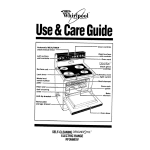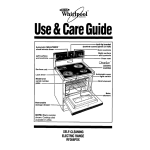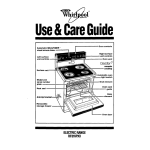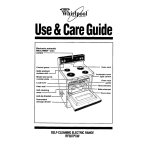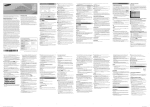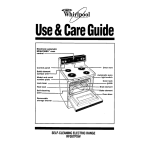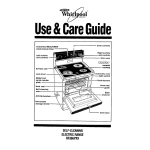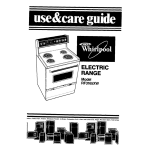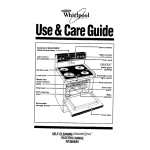Download Whirlpool RF396PXX Specifications
Transcript
Electronic MEALTIMER’” clock with oven controls and minute timer Surface ceramic unit Automatic Model oven and se Bake element Anti-tip bracket Removable storage drawer SELF-CLEANING DE=JE@LE’” ELECTRIC RANGES RF396PXXRF396PCX Contents Important Safety Instructions. ................ Using Your Range ........... Using the surface units ...... The electronic oven controls Setting the clock ............ Using the electronic Minute Timer ................... Using the Oven-Off button .... Using the oven ............. Using the electronic MEALTIMER’” control ..... Theovenvent .............. The storage drawer ......... Optional door panel pat ...... Caring for Your Range. ...... Control panel and knobs ..... Cooktop ................... Using the Self-Cleaning cycle Cleaning tips ............... The oven light .............. If You Need Service Or Assistance .............. Whirlpool Cooking Product Warranty .................... Page 8 9 9 11 15 16 16 17 17 17 19 24 25 Thank you for buying a Whirlpool appliance. Please complete and mail the Owner Registration Card provided with this product. Then complete the form below. Have this information ready if you need service or call with a question. l Copy model and serial numbers from plate (behind the oven door on the frame) and purchase date from sales slip. l Keep this book, the Cooking Guide and sales slip together in a handy place. Model Number Serial Number 26 Purchase 28 Service Dale Company Phone Number 01990 Whirlpool Corporation You are responsible for: l Installing and leveling the range on a floor strong enough to hold its weight, and where it is protected from the elements. (See the Installation Instructions.) l Making sure the range is not used by anyone unable to operate it properly. l Properly maintaining the range. l Using the range only for jobs expected of a home range. l Making sure the range is secured by a properly installed anti-tip bracket, with rear leveling leg positioned under bracket. ImportantSafetyInstructions To reduce the risk of fire, electrical shock, injury to persons, or damage when using the range, follow basic precautions, including the following: l l Read all instructions before using the range. Install or locate the range only in accordance with the provided Installation Instructions. It is recommended that the range be installed by a qualified installer. The range must be properly connected to electrical supply and grounded. l l l l l l l l To reduce the risk of tipping of the appliance, the appliance must be secured by a properly installed anti-tip bracket. To check if the bracket is installed properly, remove the storage drawer (see page 16) and verify that the anti-tip bracket is engaged. Do not use the range for warming or heating the room. Persons could be burned or injured, or a fire could start. Do not leave children alone or unattended in area where the range is in use. They should never be allowed to sit or stand on any part of the range. They could be burned or injured. Do not wear loose or hanging garments when using the range. They could ignite if they touch a hot surface unit or heating element and you could be burned. Do not repair or replace any part of the range unless specifically recommended in this manual. All other servicing should be referred to a qualified technician. Do not store flammable materials l l l l in or near the range. They could explode or burn. Do not use water on grease fires. Never pick up a flaming pan. Smother flaming pan on cooktop by covering with a well-fitted lid, cookie sheet or flat tray. Flaming grease outside of pan can be extinguished with baking soda or, if available, a multipurpose dry chemical or foam-type extinguisher. Use only dry potholders. Moist or damp potholders on hot surfaces may result in burns from steam. Do not let potholder touch hot heating elements. Do not use a towel or bulky cloth for a potholder. They could catch on fire. Select a pan with a flat bottom that is about the same size as the surface unit. If pan is smaller than the surface unit, some of the heating element will be exposed and may result in the igniting of clothing or potholders. Correct pan size also improves cooking efficiency. Never leave surface units unattended at high heat settings. A boil-over could result and cause smoking and greasy spill-overs that may ignite. Check to be sure glass cooking utensils are safe for use on the cooktop. Only certain types of glass, glass-ceramic, ceramic, earthenware or other glazed utensils are suitable for cooktops without breaking due to the sudden change in temperature. Turn pan handles inward, but not over other surface units. This will help reduce the chance of burns, igniting of flammable materials, and spills due to bumping of the pan. Important Continued l l l l l l l l l Safety Instructions fumes if applied to a hot surface. Use care when opening oven door. If a wet paper towel is used to Let hot air or steam escape before wipe spills on a hot cooking area, removing or replacing food. be careful to avoid steam burns. Do not heat unopened containers. They could explode. The hot conl Do not store things children might tents could cause burns and conwant above the range. Children could be burned or injured while tainer particles could cause injury. climbing on it. Keep range vents unobstructed. l Do not touch surface units, areas Always position oven racks in near surface units, heating eledesired location while oven is cool. ments or interior surfaces of oven. If rack must be moved while oven Surface units and heating eleis hot, do not let potholder contact ments may be hot even though hot heating element in oven. they are dark in color. Areas near Do not clean door seal. It is essensurface units and interior surfaces tial for a good seal. Care should be of an oven become hot enough to taken not to rub, damage, or move cause burns. During and after use, the seal. Clean only parts recomdo not touch, or let clothing or mended in this Use and Care other flammable materials contact Guide. surface units, areas near elements, Do not use oven cleaners. No comheating units or interior surfaces of mercial oven cleaner or oven liner oven until they have had sufficient protective coating of any kind time to cool. Other surfaces of the should be used in or around any range may become hot enough to part of the oven. cause burns; such as, the oven Before self-cleaning the oven, vent opening, the surface near the remove broiler pan, broiler grid, vent opening, the cooktop, the oven racks and other utensils. Do oven door and window. not use your oven to clean mis. FOR YOUR SAFETY. cellaneous parts. DO NOT STORE OR USE Do not cook on broken cooktop. GASOLINE OR OTHER If cooktop should break, cleaning FLAMMABLE VAPORS AND solutions and spill-overs may LIQUIDS IN THE VICINITY OF penetrate the broken cooktop and THIS OR ANY OTHER create a risk of electric shock. APPLIANCE. THE FUMES Contact a qualified technician CAN CREATE A FIRE immediately. HAZARD OR EXPLOSION. Clean cooktop with care. Some cleaners can produce noxious - SAVE THESE INSTRUCTIONS - UsingYourRange Usingthe surfaceunits 3 . ! II’; Control knobs must be pushed in before turning them to a setting. They can be set anywhere between HI and OFF. Surface unit markers The solid dot in the surface unit marker shows which surface unit is turned on by that knob. Surface unit indicator lights One of the Surface Unit Indicator Lights on the control panel will glow when a surface unit is on. Hot surface indicator lights The Hot Surface Indicator Lights on the cooktop surface will glow when the surface units are turned on. The Indicator Lights will continue to glow as long as the surface units are too hot to touch, even after they are turned off. Burn and Fire Hazard Be sure all control knobs are turned to OFF and all indicator lights are OFF when you are not cooking. Someone could be burned or a fire could start if a surface unit is accidentally left ON. NOTE: The surface elements may smoke slightly and emit a burning odor during the first few hours of use. This is normal. It is caused by the insulation material of the new ceramic cooktop elements and will not occur again. 5 Using Your Range Continued Until you get used to the settings, use the following as a guide. For best results, start cooking at the high settings; then turn the control knob down to continue cooking. Use HI to start foods cooking; to bring liquids to a boil. Use MED-HI to hold a rapid boil; to fry chicken or pancakes. Use MED for gravy, puddings and icing; to cook large amounts of vegetables. Use MED-LO to keep food cooking after startrng it on a higher setting. Use LO to keep food warm until ready to serve. Set the heat higher or lower within the LO band to keep food at the temperature you want. Using the ceramic cooktop Cooking on the ceramic cooktop is almost the same as cooking on conventional surface units. There are, however, a few differences: l The ceramic cooktop will take slightly longer to heat up than a regular surface unit. It will also take longer to cool down. Turn off the unit a few minutes before you are finished cooking. l The surface unit will glow red when it is turned on. You will see the element cycling on (glowing red) and off to maintain the proper temperature setting you have selected. l Do not use the ceramic cooktop for canning. l Sliding metal pans on the ceramic cooktop surface could leave marks. If they are not heated, metal marks can be removed using a special cooktop polishing creme. Other marks may be permanent. See pages 17 and 18 for cleaning and caring suggestions. Wiping off the cooktop before and after each use will help keep the surface free from stains and provide the most even heating. 6 l l Using a pan with a nicked or scratched bottom could damage the ceramic cooktop. Heating a soiled pan can leave a stain on the cooktop and cause scratches. Cookware Pans should be the same size or slightly larger than the surface unit to prevent boil-overs and hot handles. Use only flat-bottomed utensils on the cooktop. Flat bottoms allow maximum contact between the pans and surface units for fast, even cooking. Pans without flat bottoms and specialty items with rounded or ridged bottoms (woks, ridged bottom canners or tea kettles) will cause uneven heating and poor cooking results. To check your cookware for flatness, place a straight-edge across the bottom of each piece. Move the straight-edge around. If light shows anywhere between the pan and the straight-edge, the pan is not flat. Do not use it. See the Cooking Guide for additional cookware information. The electronicovencontrols There are three parts in the oven control section: -The digital display. -The command buttons. -The Set Knob. Instructions for each oven control are covered on the following pages. Read them carefully. When you first plug in the range, the display will show four flashing 8’s. If, after you set the clock (page 8) the display again shows four flashing 8’s; your electricity was off for a while. Reset the clock. Digital display/clock When you are not using the oven, this is an accurate digital clock. When using the oven or Minute Timer, the display will show the time, temperature Settings and what command buttons have been pressed. When showing the time of day, the display will show the hour and minutes. When using the Minute Timer, the display shows minutes and seconds in the following sequence: l For settings from 1-59 seconds, each second will show in the display. . For settings from l-10 minutes, the display will increase in 10 second increments. l For settings from lo-99 minutes, the display will increase in 1 minute increments. When using the Bake Hours and/or Stop Time, the display shows hours and minutes. The small display will show “Err” if two commands that can not be used together are entered, such as Bake and Broil. Command buttons The command buttons tell the oven what to do and in what order. A few examples: -Time Of Day tells the oven you are going to set the clock. -Oven-Off tells the oven to turn off. Each command button (except OvenOff and Self-Clean) has its own light. The light comes on when you touch the command buttons. Set Knob Once you’ve pushed a command button to tell the oven what you want it to do, you’ll use the Set Knob to set a temperature or time. Turning the Set Knob clockwise increases the number on the display. Turning the Set Knob counterclockwise decreases the number on the display. 7 Using Your Range Continued Settingthe clock 1. Push the Time Of Day button. The TIME light will show in the display. 2. While pushing the Time Of Day button, turn the Set Knob until the correct time shows in the display. 3. Release the Time Of Day button. Usingthe electronic MinuteTimer The Minute Timer does not start or stop the oven. It works like a kitchen timer. It can be set in minutes and seconds up to 99 minutes. You will hear four beeps when the set time is up. Push the Min/Sec Timer button. The TIMER light will come on and the display will show “0:OO:’ Turn the Set Knob until the desired time shows in the display. The Minute Timer will begin counting down 2 seconds after the time is set. When time is up, “End” will show in the large display and you will hear four beeps. 8 To cancel the Minute Timer: Push the Min/Sec Timer button and turn the Set Knob until “0:OO” shows in the display. or l Quickly push the Min/Sec Timer button twice. l Usingthe Oven-Offbutton The Oven-Off button will cancel any command button except tar tire Iviirr/ Set Timer button. When the Oven-Off button is pushed, “Off” will show in the large display The display will then show the time of day or, if Minute Timer is also being used, the time remainrng. Usingthe oven Baking 1. Position the rack(s) properly before turning on the oven. To change rack position, lift rack at front and pull out. The rack(s) should be placed so the top of the food will be centered in the oven. Always leave at least 1% to 2 inches (4-5 cm) between the sides of the pan and the oven walls and other pans. For more information, see the Cooking Guide. 2. Push the Bake button. “350°F” will show in the small display to indicate the preset temperature and the PREBAKE and ON lights will come on. 9 Using Your Range Continued 3. To cook at a different temperature, push the Bake button. Turn the Set Knob until the desired temperature shows in the small display. 4. The oven is preheated when you hear three beeps and the PRE- light goes off. 5. Put food in the oven. During baking, the elements will turn on and off to keep the oven temperature at the setting. The top element helps heat during baking, but does not turn red. 6. When baking is done, push the OvenOff button. “Off” will show in the display and all other displays will go off. Broiling 1. Position the rack before turning the oven on. See a reliable cookbook for recommended rack positions. 2. Put the broiler pan and food on the rack. 3. Close the door to the Broil Stop position (open about 4 inches, 10.2 cm). The door will stay open by itself. 10 4. Push the Broil button. “brl” will show in the small display and the BROIL and ON lights will come on. 5. When broiling is done, push the Oven-Off button. “Off” will show in the large display and all other displays will go off. Custom broil l If food is cooking too fast, push the Broil button and turn the Set Knob counterclockwise until 325°F shows in the small display. The CUST BROIL and ON lights will come on. l If you want food to broil slower from the start, push the Broil button and turn the Set Knob so a temperature between 150°F and 325°F (65.5% and 162.7%) shows in the small display. These temperature settings allow the broil heating element to cycle and slows cooking. The lower the temperature, the slower the cooking. The CUST BROIL and ON lights will come on. NOTE: The door must be partly open whenever the oven is being used to broil. Leaving the door open allows the oven to maintain proper temperatures. Usingthe electronic MEALTIMER’” control The electronic MEALTIMER’” control will turn the oven on and off at times you set.. .even when you are not around. Automatic baking is ideal for foods which do not require a preheated oven, such as meats and casseroles. Do not use the automatic cycle for cakes, cookies, etc...undercooking will result. 11 Using Your Range Continued To start baking now and stop automatically: 1. Position the oven rack(s) properly and place the food in the oven. 2. Make sure the clock is set to the right time of day. (See ‘Setting the clock” on page 8.) 3. Push the Bake Hours button. “0:OO” will show in the display and the BK/HR light will come on. 1 4. Turn the Set Knob clockwise until the desired baking time shows in the display. 5. Push the Bake button and set the desired temperature. The display will show the set temperature and the time remaining. The BK/HR, PREBAKE and ON lights will come on. 6. The display will count down in minutes, The oven will beep three times when the PRE- light goes off. 7. When the baking time is completed, the oven will turn off automatically, beep four times and “End” will show in the display. To delay start and stop automatically: 1. Position the oven rack(s) properly and place the food in the oven. 2. Make sure the clock is set to the right time of day. (See “Setting the clock” on page 8.) 3. Push the Bake Hours button. “0:OO” will show in the display and the BK/HR light will come on. 4. Turn the Set Knob clockwise until the desired baking time shows in the display. This example shows a desired baking time of 30 minutes. 5. Push the Stop Time button. The ST/TM light will come on. Turn the Set Knob clockwise until the desired stop time shows in the display. The time of day will show in the display and the ST/TM light will flash until Bake is selected. This example shows a desired stop time of 2 o’clock. 13 Using Your Range Continued 7. Changes can be made at any time by pressing a command button. on. The display will count down in minutes. The oven will beep three times when the PRE- light goes off. 14 To avoid sickness and food waste when using the MEALTIMER’” control: l Do not use foods that will spoil while waiting for cooking to start, such as dishes with milk or eggs, cream soups, and cooked meats or fish. Any food that has to wait for cooking to start should be very cold or frozen before it is put in the oven. MOST UNFROZEN FOODS SHOULD NEVER STAND MORE THAN TWO HOURS BEFORE COOKING STARTS. l Do not use foods containing baking powder or yeast when using delay start. They will not rise properly. l Do not allow food to remain in oven for more than two hours after end of cooking cycle. Theovenvent Hot air and moisture escape from the oven through a vent on the backguard below the control panel. The vent is needed for air circulation. Do not block the vent. Poor baking can result. O&n vent Burn Hazard When the oven is ON, pans and pan handles left near the oven vent can become hot enough to burn the user and to melt plastics. Use pot holders to move pans. Never store plastics, paper or other items that could melt or burn near the oven vent, or any of the surface units. Using Your Range Continued Thestoragedrawer The storage drawer is for storing pots and pans. The drawer can be removed to make it easier to clean under the range, and to check for installation of the anti-tip bracket. Use care when handling the drawer. Removing the storage drawer: 1. Empty drawer of any pots and pans before removing drawer. Pull drawer straight out to the first stop. Lift front and pull out to the second stop. 2. Lift back slightly and slide drawer all the way out. Replacing the storage drawer: 1. Fit ends of drawer slide rails into the drawer guides on both sides of opening. 2. Lift drawer front and push in until metal stops on drawer slide rails clear white stops on drawer guides. Lift drawer front again to clear second stop and slide drawer closed. To verify the anti-tip bracket is engaged: l Remove the storage drawer. l Look to see if the anti-tip bracket is attached to floor with screws. l Make sure one rear leveling leg is positioned under the anti-tip bracket. l See Installation Instructions for further details. NOTE: The range will not tip during normal use. Tipping can occur if excessive force or weight is applied to open door without anti-tip bracket properly secured. Optionaldoorpanelpat 16 If you would like to change the color of your oven door glass to white or almond, you can order one of these kits: White (Kit No. 814069) of Almond (Kit No. 814070) from your Whirlpool Dealer. The kits include easy installation instructions. CaringForYourRange Burn and Electrical Shock Hazard Make sure all controls are OFF and the range is cool before cleaning. Failure to do so can * sult in burns or electrical shock. Controlpanelandknobs 1. Turn control knobs to the OFF position. 2. Pull control knobs and buttons straight off. 3. Use warm soapy water or spray glass cleaner, and a soft cloth, to wipe the control panel. Rinse and wipe dry. 4. Wash control knobs and buttons in warm soapy water. Rinse well and dry. Do not soak. 5. Replace control knobs and buttons by pushing them firmly into place. NOTE: When cleaning, never use steel wool, abrasives, or commercial oven cleaners which may damage the finish. After cleaning, make sure all control knobs point to the OFF position. Make sure you have not turned oven ON when replacing buttons. If oven has been turned on, push Oven Off button. cooktop This cooktop is designed for easy care. However, for ease in cleaning and to keep the surface looking like new, the cooktop surface must be soil-free before heating. Try to get in the habit of wiping the surface with a clean, damp paper towel before each use. Cooked on soils are difficult to remove. Foods spilled directly on the surface units will not burn off as on standard open-coil burners. To maintain best appearance, see “Cleaning tips” on page 18. 17 Caring For Your Range Continued Cleaning tips Personal Injury Hazard l Allow surface unit and surrounding areas to reduce in temperature from hot to warm before removing heavy or sugary spills. Wear protective clothing such as oven mitts. l Do not use cooktop cleaner on a hot cooktop. The cleaner may produce hazardous fumes or damage the cooktop. l Do not use the range if the cooktop is cracked or broken. Failure to follow these instructions can result in personal injury. To avoid damaging the cooktop, follow these instructions: l Make sure bottoms of pans are clean and dry before using. l Avoid spill-over% Use pans with tall sides. l Do not allow anything that may melt (plastic, aluminum foil, sugar or food with high sugar content) to come in contact with the sutiace while it is hot. l Do not use the cooktop as a cutting board. l Do not place food directly on ceramic cooktop. l Do not use steel wool, plastic cleaning pads, abrasive powdered cleansers, chlorine bleach, rust remover, ammonia, glass cleaning products with ammonia or cleaning products designed for white ceramic cooktops. These could damage the cooktop surface. l Dropping heavy or hard objects on the cooktop can crack it. Be careful with heavy skillets. Don’t store jars or cans above the cooktop. 18 Light soils - Remove with a clean, damp paper towel. l Greasy soils - Remove with a soapy sponge or soft cloth -OR- with vinegar and a clean paper towel. Rinse and dry well. l Stubborn soils - Apply a vinegar soaked paper towel to the stain for lo-15 minutes. Rub off soil. Rinse and dry well. l Heavy soils - Carefully scrape heavy spills using a single edge razor blade in a holder. Remove remaining residue with a non-abrasive cleanser and a clean, damp paper towel. Rinse and dry well. l Sugary spills and soils-To avoid pitting on the cooktop, clean spills up while the glass is still warm. Follow cleaning instructions for “Heavy soils” above. Rinse and dry well. NOTE: Always rinse and dry your cooktop thoroughly after cleaning. This will prevent streaking or staining from cleaning materials. l Tiny scratches or abrasions are not removable, but do not affect cooking. In time, the scratches will become less visible as a result of cleaning. l For further care of your cooktop, use the Cooktop Polishing Creme included with your range. Use only on a clean, cool cooktop. Follow instructions on the container to remove metal marks (from copper or aluminum pans) as soon as possible. If heated, metal marks may not come off. Cooktop Polishing Creme will also remove dark streaks, specks and discolorations caused by cleaning materials or foods. NOTE: To obtain order information for Cooktop Polishing Creme (Part No. 814009), write to: Whirlpool Corporation Attention: Customer Service Dept. 1900 Whirlpool Drive LaPorte, IN 46350 l Usingthe Self-Cleaningcycle The Self-Cleaning cycle uses very high heat to burn away soil. Before you start, make sure you understand exactly how to use the Self-Cleaning cycle safely. Before you start 1. Clean the areas shown by hand. They do not get hot enough during the Self-Cleaning Cycle for soil to burn away. Use hot water and detergent or a soapy steel wool pad on... l The inside of the door. (The center area of the door does not need to be hand cleaned.) l The frame around the oven. Do not clean, move or bend the fiberglass seal. Poor cleaning and poor baking will result. Hand clean frame Donot Hand clean door around edge hand clean seal 2. Remove the broiler pan and any pots and pans you may have stored in the oven. NOTE: The broiler pan (without grid) can be cleaned in the oven only if most of the soil has been removed by handcleaning or a dishwasher. The chrome broiler grid will discolor if cleaned in the Self-Cleaning cycle. 3. Wipe out any loose soil or grease. This will help reduce smoke during the Self-Cleaning cycle. 4. If you want the oven racks to remain shiny, remove from the oven and clean by hand. Otherwise, put oven racks on second and fourth guides (guides are counted from bottom to top). After racks are 19 Caring For Your Range Continued cleaned in the Self-Cleaning cycle, they become harder to slide. See page 24. Turn on a vent hood or other kitchen vent during the Self-Cleaning cycle. This will help remove heat and odors that are normal during the cycle. Personal Injury and Product Damage Hazard l Do not touch the oven during the Self-Cleaning cycle. It could burn you. . Do not use commercial oven cleaners in your oven. Cleaners may produce hazardous fumes or damage the porcelain finish. l Do not force the Lock Lever, you could bend or break it. The lever is designed to stay locked until the oven is cool enough to safely open. Wait until it moves freely. l Do not use foil or other liners in the oven. During the Self-Cleaning cycle foil can burn or melt and damage the oven surface. l Do not block the vent during the Self-Cleaning cycle. Air must move freely for best cleaning results. l Do not leave plastic utensils near the vent. They may melt. Setting the controls 1. Make sure the clock is set to the right - time of day. (See Setting the clock” on page 8.) 2. Move the Lock Lever all the way to the right-the Clean position. 3. Push the Self-Clean button. A 3-hour Self-Cleaning cycle will be set automatically. “C3:OO” will show in the large display and “cln” will show in the small display. The ON light will come on. If a cleaning cycle other than 3 hours is desired, push the Self-Clean button. Turn the Set Knob to the new time up to 4 hours. l Use 2 hours for light soil. l Use 3-4 hours for moderate to heavy soil. 4. Skip to Step 6 if you want the SelfCleaning cycle to start now. 5. (Option) Delayed clean: Push the Self-Clean button. Immediately push the Stop Time button. Immediately turn the Set Knob to the new stop time. The DELAY and ST/TM lights will come on. After the stop time has been set, the large display will go back to showing the current time of day. The small display will show “cln” and the DELAY light will stay on. When the start time is reached, the DELAY light will go off, the ON light will come on and the oven will start to clean. 6. When the oven temperature exceeds normal baking temperatures, the door cannot be opened and the Lock Lever must not be moved. Caring For Your Range Continued 7. After the Self-Cleaning cycle is completed, the oven will beep four times and “End” WIII show in the display. BEEP@@ BEEP 6. After the Self-Cleaning Cycle iS completed and the oven temperature has dropped below approximately 520°F (271X), the Lock Lever can be moved back to the left. DO NOT FORCE IT. Wait until it moves easily. 9. After the oven is cool, wipe off any residue or ash with a damp cloth. If needed, touch up spots with a soapy steel wool pad. Special l l l tips Keep the kitchen well ventilated during the Self-Cleaning cycle to help get rid of heat, odors and smoke. Clean the oven before it gets heavily soiled. Cleaning a very soiled oven takes longer and results in more smoke than usual. If the Self-Cleaning cycle doesn’t get the oven as clean as you expected, the cycle may not have been set long enough or you may not have prepared the oven properly. Set the Self-Cleaning cycle longer the next time and hand clean areas noted on page 19. To stop the Self-Cleaning cycle at any time: 1. Push the Oven-Off button. 2. When the oven temperature drops below approximately 520°F (271”C), move the Lock Lever back to the left. DO NOT FORCE IT. Wait until it moves easily. 22 How it works During the Self-Cleaning cycle, the oven gets much hotter than it does for baking or broiling. ..approximately 675°F (466°C). This heat breaks up grease and soil and burns it off. This graph shows approximate temperatures and times during a Self-Cleaning cycle for 3 hours. Self-Cleaning cycle-three (Approximate temperatures hour setting and times) 1000°F 538°C 800°F I I I 427°C I O’.‘E 600°F 316°C 400°F 204°C 200°F START 93°C % hr. 1 hr 1 1% hrs 2 hrs. 2% hrs. 3 hrs 3% hrs STOP Notice that the heating stops when the 3-hour setting is up, but that it takes longer for the oven to cool down enough to unlock. 23 Caring For Your Range Continued Cleaningtips Control knobs Clean with warm soapy water and a soft cloth. l Wash, rinse and dry well. l Do not soak. Control panel Clean with warm soapy water or spray glass cleaner and a soft cloth. l Wash, rinse and dry well. l Follow directions provided with the cleaner. Ceramic cooktop See pages 17 and 18 for cleaning instructions. Exterior surfaces (other than cooktop and control panel) Clean with warm soapy water and a soft cloth. l Wipe off regularly when cooktop and oven are cool. Use a non-abrasive plastic scrubbing pad for heavily soiled areas. l Do not use abrasive or harsh cleansers. NOTE: Do not allow food containing acids (such as vinegar, tomato or lemon juice) to remain on surface. Acids may remove the glossy finish. Also, wipe up milk or egg spills when cooktop is cool. Broiler pan and grid Clean with warm soapy water or a soapy steel wool pad. l Clean after each use. l Wash, rinse and dry well. l Do not clean in Self-Cleaning Oven. (See note on page 19.) Oven racks Use Self-Cleaning cycle. l Leave in oven during Self-Cleaning cycle. OR Clean with warm soapy water or soapy steel wool pads. l Wash, rinse and dry. Use soapy steel wool pads for heavily-soiled areas. NOTE: The oven racks will discolor and be harder to slide when left in the oven during the Self-Cleaning cycle. If you want them to stay shiny, remove from the oven and clean by hand. If racks are left in the oven during the Self-Cleaning cycle, apply a small amount of vegetable oil to the sides of the racks to make them easier to slide. Oven door glass Use spray glass cleaner or warm soapy water and a non-abrasive plastic scrubbing pad. l Make sure oven is cool. l Follow directions provided with the cleaner. l Wash, rinse and dry well. Self-Cleaning oven For areas outside the Self-Cleaning area use warm soapy water or soapy steel wool pads. . Follow directions starting on page 19, “Using the Self-Cleaning cycle:’ l Do not use commercial oven cleaners. . Do not use foil to line the bottom of your Self-Cleaning Oven. 24 The ovenlight The oven light will come on when you open the oven door. To turn the light on when the oven door is closed, push the Oven Light Switch on the control panel. Push the switch again to turn off the light. l l Electrical Shock and Personal Injury Hazard Make sure oven and light bulb are cool and power to the range has been turned OFF before replacing the light bulb. Failure to do so could result in electrical shock or burns. The bulb cover must be in place when using the oven. The cover protects the bulb from breaking, and from high oven temperatures. Since bulb cover is made of glass, be careful not to drop it. Broken glass could cause injury. To replace the oven light: 1. Unplug appliance or disconnect at main power supply. 2. Remove the glass bulb cover in the back of the oven by screwing it out counterclockwise. 3. Remove the light bulb from its socket. Replace the bulb with a 40-watt appliance bulb. 4. Replace the bulb cover by screwing it in clockwise. Plug in appliance or reconnect at the main power supply. NOTE: The oven light will not work during the Self-Cleaning cycle. 25 If YouNeedServiceOrAssistance... Vdd;;ggest you follow these .. 1. Before calling for assistance... Performance problems often result from little things you can find and fix without tools of any kind. If nothing operates: l Is the power supply cord plugged into a live circuit with the proper voltage? (See Installation Instructions.) l Have you checked your home’s main fuses or circuit breaker box? If the oven will not operate: l Are the electronic controls set correctly? See pages 6-15. l Have you programmed a delay start time? If surface units will not operate: l Have you checked your home’s main fuses or circuit breaker box? l Do the control knobs turn? If surface unit knob(s) will not turn: l Did you push in before trying to turn? If the Self-Cleaning cycle will not operate: l Does the clock show the right time of day? l Is the Lock Lever all the way to the right? l Have you set a delay start time? 26 If cooking results aren’t what you expected: l Is the range level? l If needed, have you preheated the oven as the recipe calls for? l Are you following a tested recipe from a reliable source? l Are you using pans recommended in the Cooking Guide? l If baking, have you allowed 1% to 2 inches (4-5 cm) on all sides of the pans for air circulation? l Are the pans the size called for in the recipe? l Do the cooking utensils have smooth, flat bottoms and fit the surface elements being used? If the oven temperature seems too low or too high: l Was your old oven accurate? Your old oven may have shifted gradually while your new oven may be more exact. l If, after using the oven, you are not satisfied with the temperature settings, they can be adjusted by an authorized Whirlpools” service technician. (See “If you need service” on page 27.) If there has been a power interruption, the display will flash 88:88. Reset the clock, (page 8). If “call” shows on the display, call for service. (See “If you need service” on page 27.) See the Cooking Guide for more information on cooking problems and how to solve them. 2. If you need assistance’.. Call Whirlpool COOL-LINE@ service assistance telephone number. Dial free from anywhere in the U.S.: 1-800-253-1301 and talk with one of our trained consultants. The consultant can instruct you in how to obtain satisfactory operation from your appliance or, if service is necessary, recommend a qualified service company in your area. If you prefer, write to: Mr. Donald Skinner Director of Consumer Relations Whirlpool Corporation 2000 M-63 Senton Harbor, MI 49022 Please include a daytime phone number in your correspondence. 3. If you need service’... Whirlpool has a Si$l 4. If you need FSP” replacement parts!.. FSP is a registered trademark of Whirlpool Corporation for quality parts. Look for this symbol of quality whenever you need a replacement part for your Whirlpool appliance. FSP replacement parts will fit right and work right, because they are made to the same exacting specifications used to build every new Whirlpool appliance. To locate FSP replacement parts in your area, refer to Step 3 above or call the Whirlpool COOL-LINE service assistance number in Step 2. 5. If you are not satisfied with how the problem was solved’... l Contact the Major Appliance Consumer Action Panel (MACAP). MACAP is a group of independent consumer experts that voices consumer views at the highest levels of the major appliance industry. l Contact MACAP only when the dealer, authorized servicer or Whirlpool have failed to resolve your problem. Major Appliance Consumer Action Panel 20 North Wacker Drive Chicago, IL 60606 l MACAP will in turn inform us of your action. 01~ $~~~~~u~/~tm senVrcs rized Whirlpools” service companies. Whirlpool service technicians are trained to fulfill the product warranty and provide after-warranty service, anywhere in the United States. To locate the authorized Whirlpool service company in your area, call our COOL-LINE@ service assistance telephone number (see Step 2) or look in your telephone directory Yellow Pages under: ‘When requesting assrstance, please APPLIANCES - nO”SEnOLo - ELECTRICAL APPLIANCES - REPNRING L PARTS provide: model number, serial number, MAJORSERWCE a REPAIR MAJOR OR date of purchase, and a complete WASNING MACMNES, DRIERS description of the problem. This inforC IRONERS-SERVICING WHlRLPOOL APPLlANCES mation is needed in order to better AUTHORIZE0 WHIRLPOOL SERVICE respond to your request. 2 27 WHIRLPOOL CleanTop’” CookingProductWarranty EROO: LENGTH OF WARRANTY WHIRLPOOL WILL PAY FOR FULL ONE-YEAR WARRANTY From Date of Purchase FSPB replacement parts and repair labor to correct defects in material or workmanship. Service must be provided by an authorized WhirlooolSM service company. LIMITED FOUR-YEAR WARRANTY Second Through Fifth Year From Date of Purchase FSP replacement parts for CleanTop ceramic cooktop to the original purchaser of this product. Whirlpool warrants that: -The ceramic cooktop will not discolor -The ceramic cooktop pattern will not wear off -The rubber seal between the ceramic cooktop and porcelain edge will not crack -The ceramic cooktop will not crack due to thermal shock -The surface units will not burn out WHIRLPOOL WILL NOT PAY FOR A. Service calls to: 1. Correct the installation of the cooking product. 2. Instruct you how to use the cooking product. 3. Replace house fuses or correct house wiring. 4. Replace owner accessible light bulbs. B. Repairs when the cooking product is used in other than normal, single-family household use. C. Pick up and delivery. This product is designed to be repaired in the home. D. Damage to the cooking product caused by accident, misuse, fire, flood, acts of God or use of products not approved by Whirlpool. E. Any labor costs during limited warranty. F. Repairs to CleanTop ceramic cooktop if it has not been cared for as recommended in this Use and Care Guide. WHIRLPOOL CORPORATION SHALL NOT BE LIABLE FOR INCIDENTAL OR CONSEQUENTIAL DAMAGES. Some states do not allow the exclusion or limitation of incidental or consequential damages so this limitation or exclusion may not apply to you. This warranty gives you specific legal rights, and you may also have other rights which vary from state to state. Outside the United States, a different warranty may also apply. For details, please contact your authorized Whirlpool distributor or military exchange. If you need service, first see the “Service and Assistance” section of this book. After checking “Service and Assistance,” additional help can be found by calling our COOL-LINE@ service assistance telephone number, l-800-253-1301, from anywhere in the U.S. @Registered Trademark/TM Part No. 3150274 01990 Whirlpool Corporation Trademark/SM Service Mark of Whirlpool Corporation Printed in U.S.A.




























